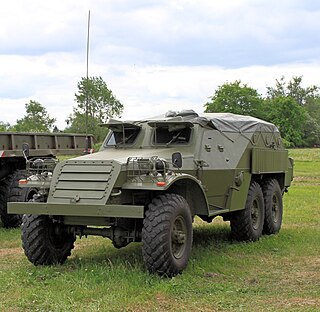
The BTR-152 is a six-wheeled Soviet armored personnel carrier (APC) built on the chassis and drive train of a ZIS-151 utility truck. It entered service with a number of Warsaw Pact member states beginning in 1950, and formed the mainstay of Soviet motor rifle battalions until the advent of the amphibious BTR-60 series during the 1960s. BTR stands for bronetransportyor.

Arena is an active protection system (APS) developed at Russia's Kolomna-based Engineering Design Bureau for the purpose of protecting armoured fighting vehicles from destruction by light anti-tank weapons, anti-tank guided missiles (ATGM), and flyover top attack missiles. It uses a Doppler radar to detect incoming warheads. Upon detection, a defensive rocket is fired that detonates near the inbound threat, destroying it before it hits the vehicle.
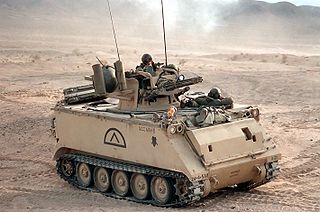
The M163 Vulcan Air Defense System (VADS), officially Gun, Air Defense Artillery, Self-Propelled 20-mm, M163, is a self-propelled anti-aircraft gun (SPAAG) that was primarily used by the United States Army. The M163 provides mobile, short-range air defense protection for ground units against low-flying fixed-wing aircraft and helicopters. It replaced the M42 Duster as the standard American armored light air-defense gun.

The ZU-23-2, also known as ZU-23, is a Soviet towed 23×152mm anti-aircraft twin-barreled autocannon. ZU stands for Zenitnaya Ustanovka – anti-aircraft mount. The GRAU index is 2A13.
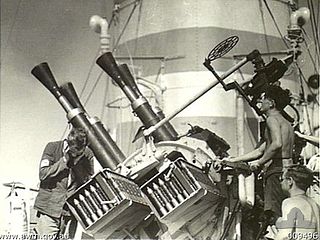
The 2-pounder gun, officially the QF 2-pounder and universally known as the pom-pom, was a 40 mm (1.6 in) British autocannon, used as an anti-aircraft gun by the Royal Navy. The name came from the sound that the original models make when firing. This QF 2-pounder was not the same gun as the Ordnance QF 2-pounder, used by the British Army as an anti-tank gun and a tank gun, although they both fired 2 lb (0.91 kg), 40 mm (1.6 in) projectiles.
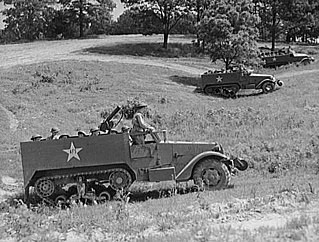
The M3 half-track was an American armored personnel carrier half-track widely used by the Allies during World War II and in the Cold War. Derived from the M2 half-track car, the M3 was extensively produced, with about 15,000 standard M3s and more than 38,000 variant units manufactured.

The QF 3.7-inch AA was Britain's primary heavy anti-aircraft gun during World War II. It was roughly the equivalent of the German Flak 8.8 cm and American 90 mm, but with a slightly larger calibre of 3.7 inches, approximately 94 mm. Production began in 1937 and it was used throughout World War II in all theatres except the Eastern Front. It remained in use after the war until AA guns were replaced by guided missiles beginning in 1957.
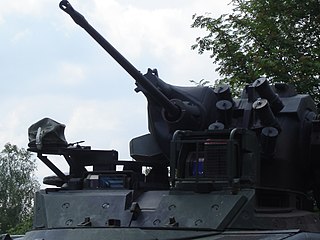
The Rheinmetall Mk 20 Rh-202 is a 20 mm caliber autocannon designed and produced by Rheinmetall. It fires the 20×139mm ammunition originally developed for the Hispano-Suiza HS.820.

SON-30 is a type of Russian/Soviet fire director radar for 130 mm anti-aircraft guns. It was a Soviet derivative of the US SCR-584 system.

The OTO-Melara Mod 56 is an Italian-made 105 mm pack howitzer built and developed by OTO Melara. It fires the standard US type M1 ammunition.

AZP S-60 is a Soviet towed, road-transportable, short- to medium-range, single-barrel anti-aircraft gun from the 1950s. The gun was extensively used in Warsaw Pact, Middle Eastern and South-East Asian countries.

The 130 mm towed field gun M-46 is a manually loaded, towed 130 mm artillery piece, manufactured in the Soviet Union in the 1950s. It was first observed by the West in 1954.

The KS-19 100mm anti-aircraft gun is a Soviet anti-aircraft gun that also features good capabilities against ground targets.
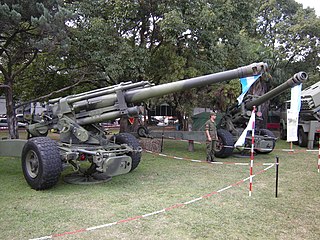
The 155mm L33 Argentine Model gun is an Argentine artillery field gun in service with the Argentine Army.

The 10.5 cm leFH 18/40 was a German light howitzer used in World War II.

The 85-mm divisional gun D-44 was a Soviet divisional 85-mm calibre field artillery gun used in the last action of World War II. It was designed as the replacement for the 76 mm divisional gun M1942 (ZiS-3). The gun was no longer in front-line service with the Russian Ground Forces, until being pressed back into service in the Russo-Ukrainian War in 2023. Wartime service included use by communist forces during the Vietnam War and by Arab forces during their conflicts with Israel.
The Bofors 57 mm m/54 was a wheeled automatic anti-aircraft gun for land based use produced by Bofors and developed from the similar Bofors 57 mm m/50 naval artillery gun. The gun was developed in the 1950s and fielded by both the Belgian and Swedish military.

The Soviet 160 mm Mortar M-160 is a smoothbore breech loading heavy mortar which fired a 160 mm shell. It replaced the 160mm Mortar M1943 in Soviet service after World War II.
Christopher Frank Foss is a British military information author. Between 1970-2017, he worked for the military information publisher Jane's Information Group as editor of Janes Armour and Artillery, Jane’s Armoured Fighting Vehicles, Jane's AFV System Upgrades and co-editor of other Jane's editions such as Jane’s Artillery and Air Defence and Jane's Military Vehicles and Logistics. After stepping back in late 2017, Foss stayed on as a Consulting Editor with Janes for Jane's Defence Weekly and Jane's International Defence Review until late 2021. Since then he has continued writing articles for other military information publishers such as Shepard Media. During his career at Janes he was responsible for launching Jane’s Defence Review which later spun off into Jane's Soviet Intelligence Review and later Jane's Intelligence Review.

The 105×617mm, also known as 105×617mmR, is a common, NATO-standard, tank gun cartridge used in 105mm guns such as those derived from the Royal Ordnance L7.


















